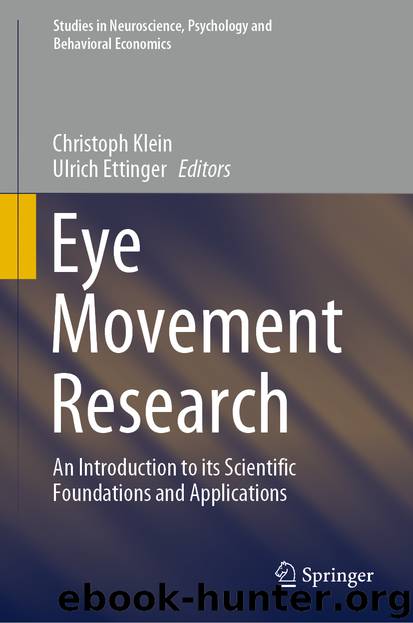Eye Movement Research by Unknown

Author:Unknown
Language: eng
Format: epub
ISBN: 9783030200855
Publisher: Springer International Publishing
Box 2: Normalising the Cerebellum in fMRI
fMRI has significantly expanded our understanding of the neural bases of cognition and eye movement control, particularly in cortical and subcortical networks. While more work is required, we currently have a satisfactory understanding of the physiological basis of the BOLD fMRI response in the cortex, and how it relates to the underlying neuronal activity. However by comparison, progress in understanding the cerebellar contributions to cognition generally, and eye movements more specifically, using fMRI has been much slower. This is linked to a poorer understanding of the physiological contributors of the BOLD response in the cerebellum, and the substantial differences in neuronal architecture and firing rates in the cerebellum (see Diedrichsen et al., 2010 for a review).
Another major issue in imaging the cerebellum using fMRI is the anatomical architecture of the region - the cerebellum consists of a number of small, tightly packed lobules and sub-lobules with considerable inter-individual variability in size, shape and location (Diedrichsen, 2006; Schmahmann, Doyon, et al., 2000). Thus, standard whole-brain normalisation of images across individuals tends to show a high level of error and low reliability in the cerebellum. Furthermore, during image acquisition, it is not uncommon for researchers to preferentially image the cortex over the cerebellum. This leads to high rates of partial sampling of the cerebellum, particularly in individuals with head size greater than the study field-of-view. Researchers conducting eye movement studies should ensure they use a field-of-view that is adequate to accommodate both cortex and cerebellum in all participants.
Diedrichsen and colleagues have made significant advances in improving the normalisation of the cerebellum, using cerebellum-specific, non-linear normalisation (Diedrichsen, 2006). Figure 12.7 describes the modified procedure for preprocessing and analysis required by SUIT. Briefly, slice time correction and realignment are conducted in the typical manner. The anatomical scan is then centred at the anterior commissure, and the functional images are then registered to the anatomical scan. The single subject GLM is then conducted, and the subsequent analyses are conducted on the parameter estimate images. The cerebellum and brainstem are then isolated from the rest of the brain on the anatomical scan. The resulting image is then corrected manually, and the automated cropped image and manually-corrected image are then normalised to the SUIT template image. The resulting deformation field is then applied to the functional parameter estimate scans, and these images are then entered into the group-level random effects analysis.
Fig. 12.7Normalisation of the cerebellum using SUIT (http://www.diedrichsenlab.org/imaging/suit_fMRI.htm)
Download
This site does not store any files on its server. We only index and link to content provided by other sites. Please contact the content providers to delete copyright contents if any and email us, we'll remove relevant links or contents immediately.
Becoming by Michelle Obama(9298)
The Last Black Unicorn by Tiffany Haddish(5078)
Beartown by Fredrik Backman(4429)
Man's Search for Meaning by Viktor Frankl(3646)
The Book of Joy by Dalai Lama(3231)
In a Sunburned Country by Bill Bryson(2951)
The Choice by Edith Eva Eger(2901)
The Five People You Meet in Heaven by Mitch Albom(2845)
Full Circle by Michael Palin(2780)
The Mamba Mentality by Kobe Bryant(2674)
The Social Psychology of Inequality by Unknown(2312)
Book of Life by Deborah Harkness(2269)
The Checklist Manifesto by Atul Gawande(2207)
Less by Andrew Sean Greer(2194)
The Big Twitch by Sean Dooley(2045)
No Room for Small Dreams by Shimon Peres(1992)
No Ashes in the Fire by Darnell L Moore(1984)
A Burst of Light by Audre Lorde(1982)
Imagine Me by Tahereh Mafi(1937)
